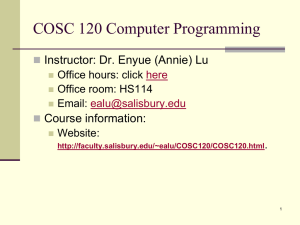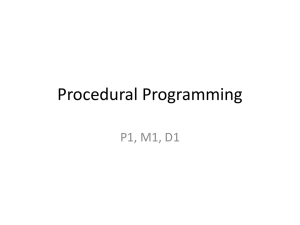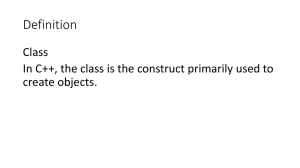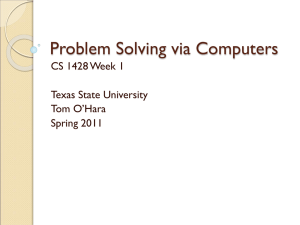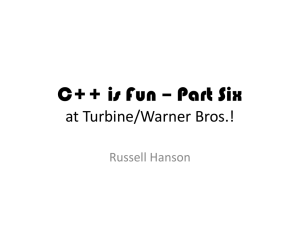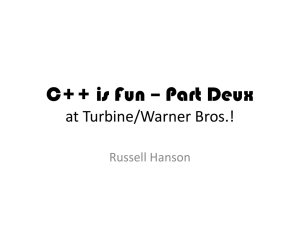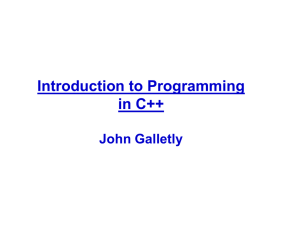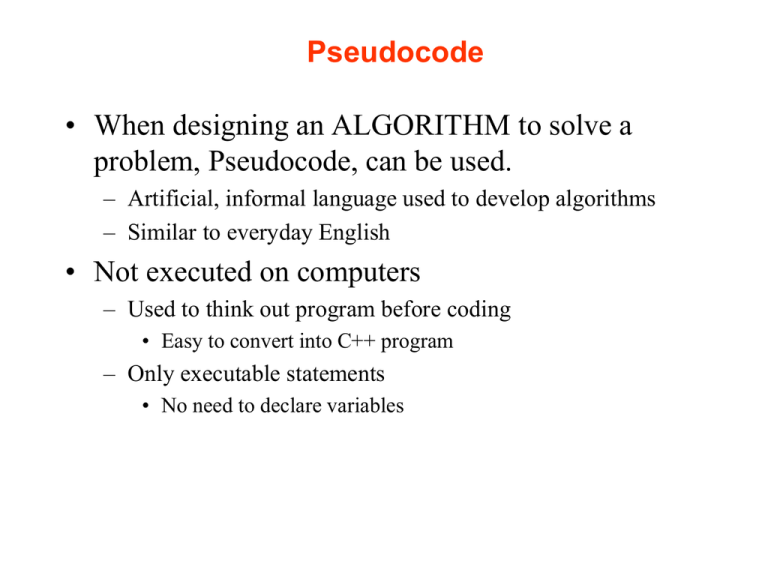
Pseudocode
• When designing an ALGORITHM to solve a
problem, Pseudocode, can be used.
– Artificial, informal language used to develop algorithms
– Similar to everyday English
• Not executed on computers
– Used to think out program before coding
• Easy to convert into C++ program
– Only executable statements
• No need to declare variables
2.4
Control Structures
• Sequential execution
– Statements executed in order
• Transfer of control
– Next statement executed not next one in sequence
• 3 control structures (Bohm and Jacopini)
– Sequence structure
• Programs executed sequentially by default
– Selection structures
• if, if/else, switch
– Repetition structures
• while, do/while, for
2.4
Control Structures
• Flowchart
– Graphical representation of an algorithm
– Special-purpose symbols connected by arrows (flowlines)
– Rectangle symbol (action symbol)
• Any type of action
– Oval symbol
• Beginning or end of a program, or a section of code (circles)
• Single-entry/single-exit control structures
– Connect exit point of one to entry point of the next
– Control structure stacking
2.5
if Selection Structure
• Selection structure
– Choose among alternative courses of action
– Pseudocode example:
If student’s grade is greater than or equal to 60
Print “Passed”
– If the condition is true
• Print statement executed, program continues to next statement
– If the condition is false
• Print statement ignored, program continues
– Indenting makes programs easier to read
• C++ ignores whitespace characters (tabs, spaces, etc.)
2.5
if Selection Structure
• Translation into C++
If student’s grade is greater than or equal to 60
Print “Passed”
if ( grade >= 60 )
cout << "Passed";
• Diamond symbol (decision symbol)
– Indicates decision is to be made
– Contains an expression that can be true or false
• Test condition, follow path
• if structure
– Single-entry/single-exit
2.5
if Selection Structure
• Flowchart of pseudocode statement
A decision can be made on
any expression.
grade >= 60
true
zero - false
print “Passed”
nonzero - true
Example:
false
3 - 4 is true
2.6
if/else Selection Structure
• if
– Performs action if condition true
• if/else
– Different actions if conditions true or false
• Pseudocode
if student’s grade is greater than or equal to 60
print “Passed”
else
print “Failed”
• C++ code
if ( grade >= 60 )
cout << "Passed";
else
cout << "Failed";
2.6
if/else Selection Structure
• Ternary conditional operator (?:)
– Three arguments (condition, value if true, value if false)
• Code could be written:
cout << ( grade >= 60 ? “Passed” : “Failed” );
Condition
false
print “Failed”
Value if true
grade >= 60
Value if false
true
print “Passed”
2.6
if/else Selection Structure
• Nested if/else structures
– One inside another, test for multiple cases
– Once condition met, other statements skipped
if student’s grade is greater than or equal to 90
Print “A”
else
if student’s grade is greater than or equal to 80
Print “B”
else
if student’s grade is greater than or equal to 70
Print “C”
else
if student’s grade is greater than or equal to 60
Print “D”
else
Print “F”
2.6
if/else Selection Structure
• Example
if ( grade >= 90 )
cout << "A";
else if ( grade >= 80 )
cout << "B";
else if ( grade >= 70 )
cout << "C";
else if ( grade >= 60 )
cout << "D";
else
cout << "F";
// 90 and above
// 80-89
// 70-79
// 60-69
// less than 60
2.6
if/else Selection Structure
• Compound statement
– Set of statements within a pair of braces
if ( grade
cout <<
else {
cout <<
cout <<
>= 60 )
"Passed.\n";
"Failed.\n";
"You must take this course again.\n";
}
– Without braces,
cout << "You must take this course again.\n";
always executed
• Block
– Set of statements within braces
1.25 Decision Making: Equality and
Relational Operators
Sta nd a rd a lg eb ra ic
eq ua lity op era tor or
rela tiona l op era tor
C++ eq ua lity
or rela tiona l
op era tor
Exa m p le
of C++
c ond ition
Mea ning of
C++ c ond ition
>
>
x > y
x is greater than y
<
<
x < y
x is less than y
>=
x >= y
x is greater than or equal to y
<=
x <= y
x is less than or equal to y
=
==
x == y
x is equal to y
!=
x != y
x is not equal to y
Relational operators
Equality operators
Values of Relational Expressions
a-b
a<b
a>b
a <= b
a >= b
positive
0
1
0
1
zero
0
0
1
1
negative
1
0
1
0
Equality Operators Exmaples
Valid
----------------------------------------c == ‘A’
k != -2
y == 2 * z – 5
Not Valid
---------------------------------------a=b
// assignment statement
a==b–1
// space not allowed
y =! z
// this is equivalent to y = (!z)
2003 Prentice Hall, Inc. All rights reserved.
Numerical Accuracy
•
Many decimal numbers cannot be exactly
represented in binary by a finite number of bits.
Thus testing for exact equality can fail.
Use the technique:
|operand1 - operand2| < epsilon
Ex.
x/y == 17
abs(x/y - 17) < 0.000001
*
Logical Operators
• Negation (unary)
!
• Logical and
&&
• Logical or
||
*
Logical Operators: Examples
Valid
(a < 9) && (b> 7)
((a< 6) || (b > 8)) && (c< 7)
!(a < b) && c > k
3 && (-2 * a + 7)
a > l &&
a>9 | | b <m
a> 9 & b<8
&b
Not Valid
// one operand missing
// extra space not allowed
// this is a bitwise operation
// the address of b
**
Logical Operators: Examples
int a = 0, b = 3, c = 1, d =4;
a && !c || d
F
F
b
b
b
T
***
Logical Operators
Expression
!(a == b)
!(a == b || a == c)
!(a == b && c > d)
Expression
Equivalent
a != b
a != b && a != c
a != b || c <= d
***
Operator Precedence and Associativity
Operators
Associativity
not () ++(postfix) ! --(postfix)
+ (unary) - (unary) ++ (prefix) -- (prefix)
left to right
right to left
left to right
left to right
left to right
left to right
left to right
left to right
right to left
right to left
left to right
arithmetic
*
/
%
+ <= > >=
relational <
== !=
&&
logical
||
?:
= += -= *= /=
, (comma operator)
etc.
The Empty Statement
The empty statement is written as a semicolon.
Example:
;
// an empty statement
Other statements:
a = b;
// an assignment statement
a + b + c;
// legal, no useful work done
cout << a() << "\n"; // a function call
Common Errors!
==
means equality
=
used for assignment
FALSE is zero
TRUE is nonzero
Boolean operators give a Boolean result
**
2.16 switch Multiple-Selection Structure
• switch
– Test variable for multiple values
– Series of case labels and optional default case
switch ( variable ) {
case value1:
statements
break;
case value2:
case value3:
statements
break;
default:
statements
break;
}
// taken if variable == value1
// necessary to exit switch
// taken if variable == value2 or == value3
// taken if variable matches no other cases
2.16 switch Multiple-Selection Structure
case a
true
case a action(s)
break
case b action(s)
break
case z action(s)
break
false
case b
true
false
.
.
.
case z
false
default action(s)
true
The switch Statement
Syntax
switch (expression)
{
no ;
case value1:
statement1; use :
break;
case value2:
statement2;
break;
case valuen:
statementn;
break;
default:
statement;
}
**
The switch Statement
Syntax
switch (expression)
{
no ;
case value1:
statement1; use :
break;
case value2:
statement2;
break;
case valuen:
statementn;
break;
default:
statement;
}
char let_grd;
cout <<“Please type in your grade”<<endl;
cin >> let_grd;
switch (let_grd)
{
case ‘A’:
cout << “Congratulations!”;
break;
case ‘B’:
cout << “Good job!”;
break;
case ‘C’:
cout << “ok, but you can do better!”;
break;
cont.
The switch Statement
case ‘D’:
cout << “Better luck in PMII”;
break;
case ‘F’:
cout << “ Have fun in summer school!”;
break;
default:
cout << “You entered an invalid grade.”;
}
next statement
The switch and Break Statement
switch (let_grd)
{
case ‘A’:
cout << “Congratulations!”;
break;
case ‘B’:
cout << “Good Job!”;
break;
case ‘C’:
cout << “OK, but you can do better!”;
break;
case ‘D’:
cout << “Better luck in PMII!”;
break;
case ‘E’:
cout << “Have fun in summer school!”;
break;
default:
cout << “You entered an invalid grade.”;
}
The break Statement
switch (let_grd)
{
case ‘A’:
case ‘B’: cout << “Good Work”;
break;
case ‘C’: cout << “ok!”;
break;
case ‘D’:
case ‘E’: cout << “Have fun in
summer school!”;
}
The break Statement
switch (let_grd)
{
case ‘A’:
case ‘a’:
case ‘B’:
case ‘b’: cout << “Good Work”;
break;
case ‘C’:
case ‘c’: cout << “OK!”;
break;
etc.

